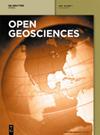Numerical modeling of site response at large strains with simplified nonlinear models: Application to Lotung seismic array
IF 1.3
4区 地球科学
Q3 GEOSCIENCES, MULTIDISCIPLINARY
引用次数: 0
Abstract
Site response analyses at large strains are routinely carried out neglecting the shear strength of soil and the stiffness degradation due to the increase in pore pressures, leading to unrealistic predictions of the seismic response of soil deposits. The study investigates the performance of a simplified nonlinear (NL) approach, implemented in the Deepsoil code, constituted by coupling a hyperbolic model incorporating shear strength with a strain-based semi-empirical pore pressure generation model. The first part of the study, based on a large one-dimensional parametric study, shows that above a shear strain of 0.1%, it is necessary to include shear strength in the site response modelling to get more realistic results. Then, the approach has been evaluated with reference to the well-known downhole Large-Scale Seismic Test array located in Lotung (Taiwan): numerical results have been compared with recordings in terms of acceleration response spectra and pore water pressure time histories at different depths along the soil profiles. The comparison shows that the NL simplified model is characterized by an accuracy comparable with more sophisticated advanced elasto-plastic NL analyses adopting essentially the same input data of the traditional equivalent linear approaches(shear modulus and damping curves) and simple physical-mechanical properties routinely determined during geotechnical surveys (i.e., shear strength, relative density, fine content). This approach is therefore recommended for site response analyses reaching large strains (i.e., soft soil deposits and moderate-to-high input motions).用简化非线性模型对大应变下的场地响应进行数值建模:Lotung 地震阵列的应用
在进行大应变下的场地响应分析时,通常会忽略土壤的抗剪强度以及孔隙压力增加导致的刚度下降,从而导致对土壤沉积物地震响应的预测不切实际。本研究调查了 Deepsoil 代码中实施的简化非线性(NL)方法的性能,该方法由包含剪切强度的双曲线模型和基于应变的半经验孔隙压力生成模型组成。研究的第一部分以大型一维参数研究为基础,表明在 0.1% 的剪切应变以上,有必要在场地响应建模中加入剪切强度,以获得更真实的结果。然后,参考位于台湾乐东的著名井下大规模地震试验阵列对该方法进行了评估:将数值结果与土壤剖面上不同深度的加速度响应谱和孔隙水压力时间历史记录进行了比较。比较结果表明,NL 简化模型的准确性可与更复杂的高级弹塑性 NL 分析相媲美,而且采用的输入数据与传统等效线性方法(剪切模量和阻尼曲线)基本相同,物理力学性质也很简单,通常在岩土工程勘测中确定(即剪切强度、相对密度、细粒含量)。因此,建议采用这种方法对达到较大应变的场地进行响应分析(即软土沉积和中高输入运动)。
本文章由计算机程序翻译,如有差异,请以英文原文为准。
求助全文
约1分钟内获得全文
求助全文
来源期刊

Open Geosciences
GEOSCIENCES, MULTIDISCIPLINARY-
CiteScore
3.10
自引率
10.00%
发文量
63
审稿时长
15 weeks
期刊介绍:
Open Geosciences (formerly Central European Journal of Geosciences - CEJG) is an open access, peer-reviewed journal publishing original research results from all fields of Earth Sciences such as: Atmospheric Sciences, Geology, Geophysics, Geography, Oceanography and Hydrology, Glaciology, Speleology, Volcanology, Soil Science, Palaeoecology, Geotourism, Geoinformatics, Geostatistics.
 求助内容:
求助内容: 应助结果提醒方式:
应助结果提醒方式:


